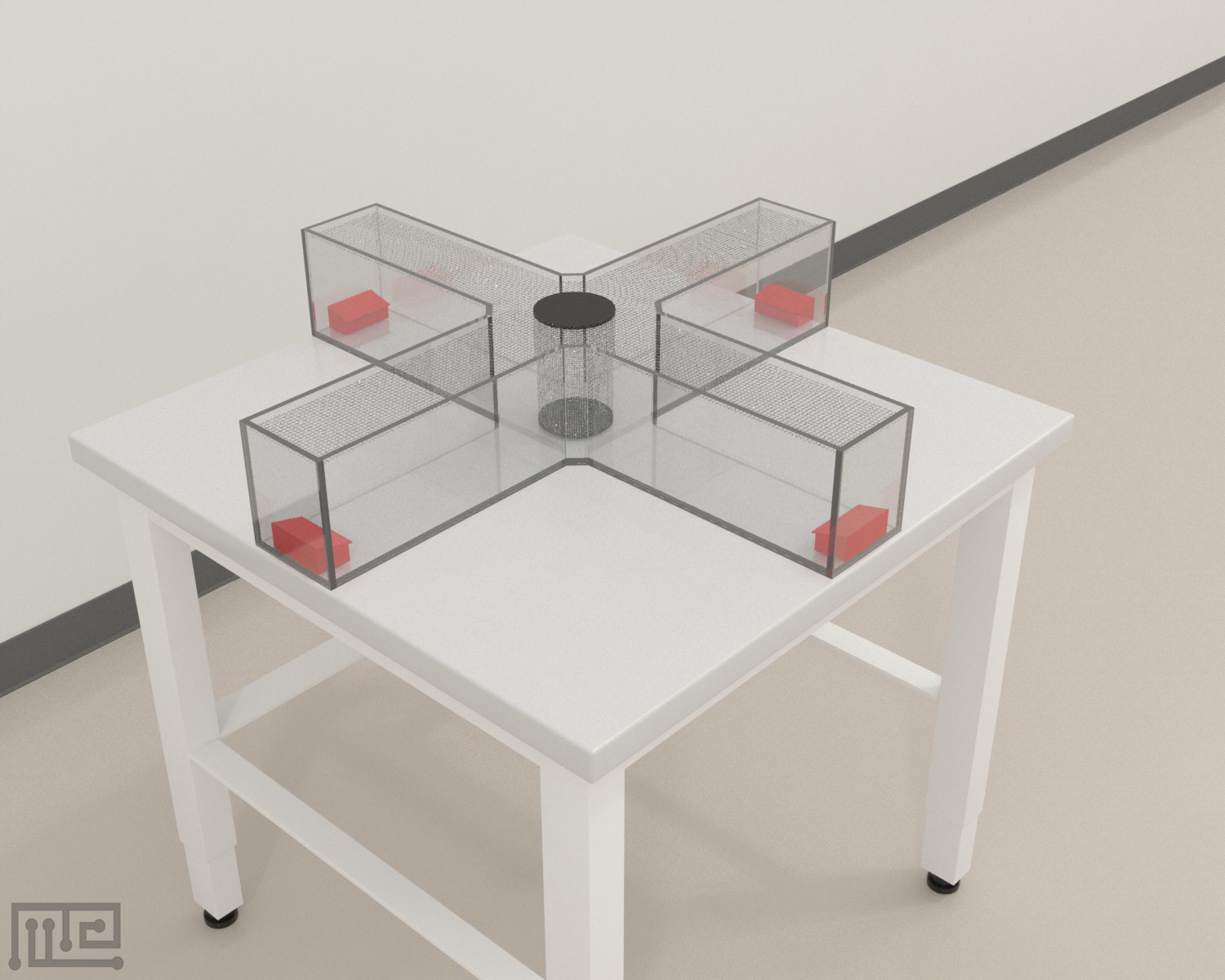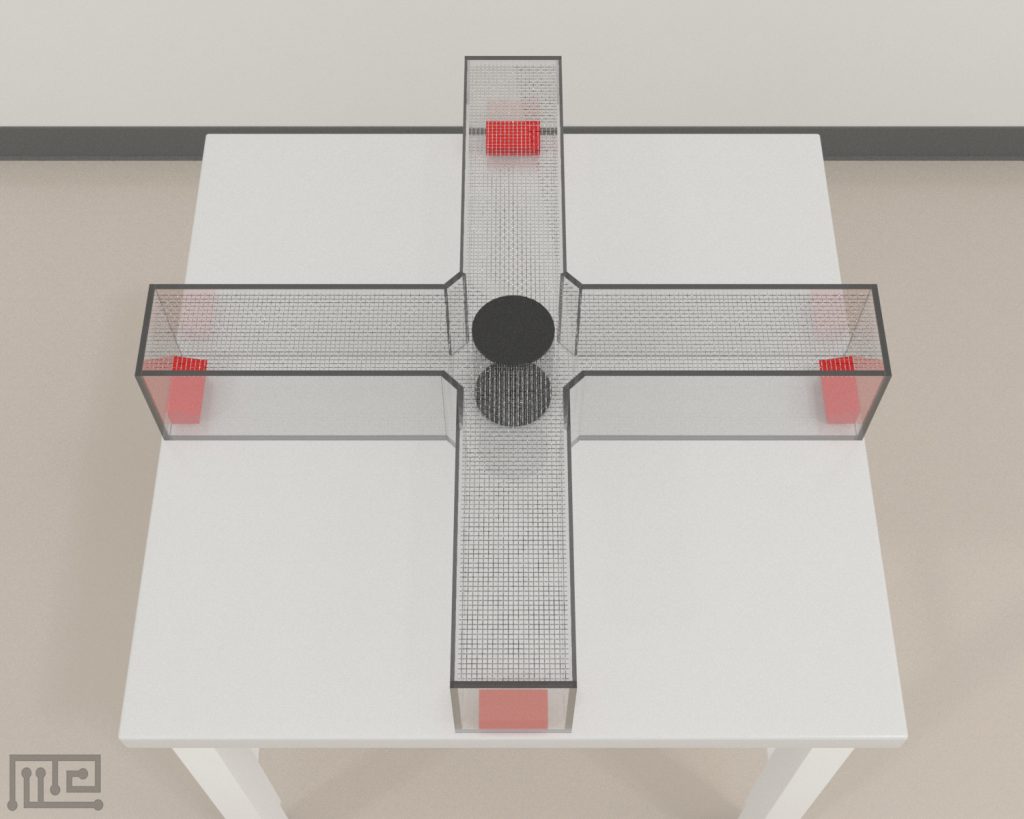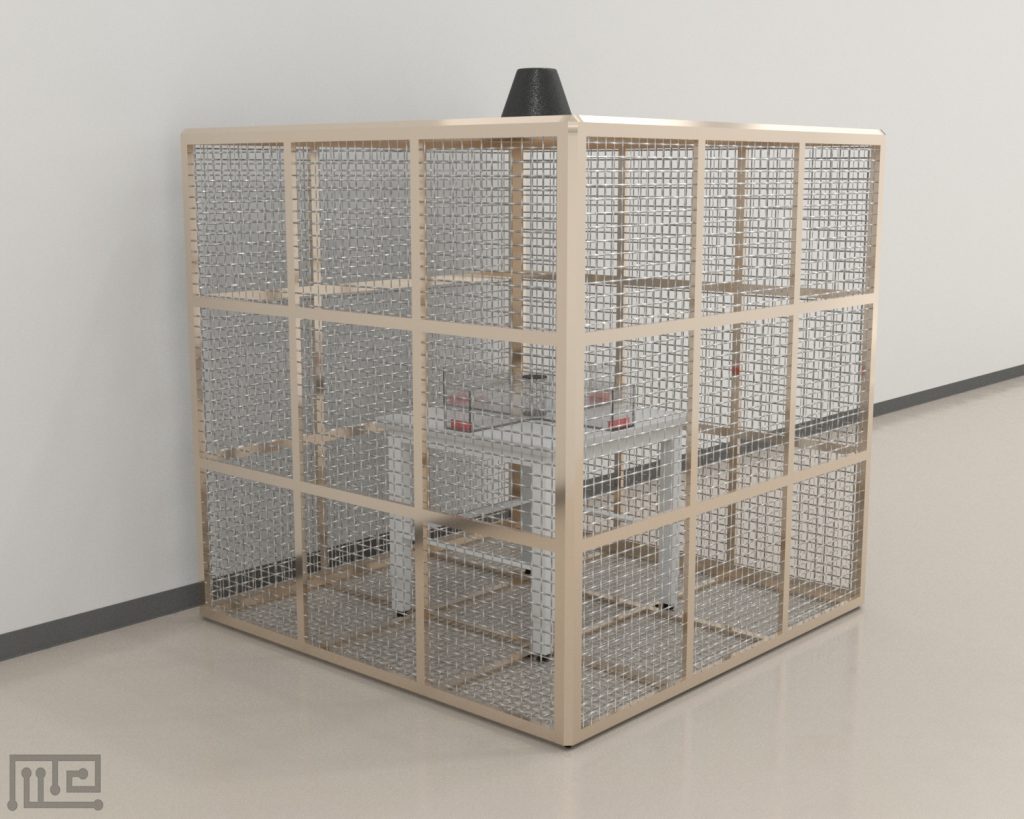The Magnetic Compass was used in a test to show that polarized light modulates light-dependent magnetic compass orientation in birds by Rachel Muheim et al. (2015).
The maze was centered in a magnetic coil (Merritt design), thus the magnetic field could be directed toward any of the four maze arms [mN at geographic north (gN), geographic south (gS), geographic east (gE), or geographic west (gW)].
Individual birds were trained to find a food reward at the end of each of the four arms. The food reward (during training trials only) is hidden in one of the four red trays. At the center of the maze there is a release device from where the birds are remotely released to explore the maze. The unpolarized light source is centered above the maze. Linear polarizers and/or depolarizers can be inserted in a filter holder just below the light source.
Mazeengineers offers the Magnetic Compass.
Price & Dimensions
Magnetic Compass
$ 1990
+S&H- Length of maze: 1.2m
- Width of maze: 1.2m
- Length of magnetic coil: 2m
- Width of magnetic coil: 2m
- Height of magnetic coil: 2m
Documentation
Introduction
The Magnetic Compass is used to study spatial orientation in birds when presented with magnetic cues and/or polarized or unpolarized light cues. It is a four-arm plus maze that is centered in a magnetic coil, which allows the magnetic field to be directed towards any of the four arms of the maze. An unpolarized light source is present one meter above the maze in which linear polarizers and/or depolarizes can be inserted in a filter holder just below the light source.
Magnetic compass orientation is present in several animals, including birds, where they utilize information from the Earth’s magnetic field for orientation and navigation for migratory purposes. However, magnetic compass orientation has also been observed in non-migratory birds such as chickens and zebra finches in behavioral tasks involving orientation towards a magnetic direction associated with a social stimulus or a food reward (Denzau, Nießner, Rogers, & Wiltschko, 2013; Voss, Keary, & Bischof, 2007). The Magnetic Compass is a spatial orientation assay that can effectively be used to observe magnetic compass orientation under different experimental conditions. The subjects are trained to locate the correct food tray in one of the four arms of the maze. Probe trials are then performed without the presence of the food trays to observe in what direction of the maze the subjects orient themselves. The subjects can be tested under unpolarized light, or in the presence of overhead polarized light. The polarized light can be aligned perpendicular or parallel to the horizontal component of the magnetic field. In addition, the subjects’ orientation can also be observed along an overhead polarized light axis in a vertical magnetic field. Furthermore, the subjects’ orientation can also be observed without using magnetic or polarized light cues by training them to locate a specific colored food tray among four trays of different colors in a local geomagnetic field.
Other apparatuses used to study different behaviors in birds include the Hen T-Maze, the Zebrafinch Day Escape Maze, the Zebrafinch Testing Cage, and the Zebrafinch Two Compartment Cage.
Apparatus and Equipment
The Magnetic Compass consists of a four-arm plus maze that measures 1.2 m in length and 1.2 m in width. The maze is made of transparent acrylic and covered with plastic mesh on top. A cylinder that is also made of transparent acrylic with a mesh top is placed in the center of the maze to release the subject into the maze. At the end of each maze arm, a red tray is placed in which food rewards can be placed. The maze is centered on a wooden table inside a magnetic coil that measures 2 m in length and 2 m in width and is aligned along with the cardinal magnetic directions. The magnetic field can be directed at any of the four arms of the maze [mN at geographic north (gN), geographic south (gS), geographic east (gE), or geographic west (gW)]. Light is provided inside the maze through a central light source that is present 1 m above the maze. Linear polarizers and/or depolarizers can be inserted in a filter holder just below the overhead light source.
Training Protocol
Clean the apparatus thoroughly in between trials to avoid odor cues from previous trials. Appropriately light the maze arena. A tracking and recording system such as the Noldus Ethovision XT can be used to assist with observations
Magnetic Compass Training Task
Place the subject in a dark bird bag and transport it to the testing room. Place the subject inside the central release cylinder in complete darkness. Switch on the arena lights. After 30 seconds, lift the release cylinder and allow the subject to exit the cylinder and explore the maze. Allow the subject to enter a maze arm and hop onto the food tray. If the subject hops on to a wrong, empty tray, punish the subject with complete darkness by switching off the arena lights for 5-10 seconds. Allow the subject to find the correct tray and allow it to consume the food reward for 30-60 seconds once it finds it. Remove the subject from the maze and return it to its home cage. If the subject can find the food reward without entering more than 8-10 arms, allow it to perform another training session after 30-90 minutes. Rotate the location of the rewarded arm by ±90° with the alignment of the magnetic compass and/or polarized light cues between the two training sessions. Train the subject under one of the three training conditions: (i) train the subject under unpolarized light to either mN or mS or mN, mS, mE, or mW. ; (ii) train the subject to either mN or mS in the presence of overhead polarized light aligned parallel or perpendicular to the horizontal component of the magnetic field; (iii) train the subject along an overhead polarized light axis. Balance the number of subjects trained to the different magnetic training directions.
Magnetic Compass Probe Task
If the subject successfully performs both training trials, allow it to perform probe trials. Conduct probe trials a day after training trials. Conduct trials in the same manner as training trials; however, do not bait any of the food trays. Allow the subject to explore the maze and search for the food for 90 seconds. Place a baited food tray in the correct arm at the end of the probe trial to reinforce training, or place the baited tray in the center of the maze to prevent them from learning anything.
Literature Review
Investigation of the effect of polarized light on spatial orientation on the Magnetic Compass
Muheim, Sjöberg, and Pinzon-Rodriguez (2016) investigated the interaction between polarized light and the Magnetic Compass in zebra finches (Taeniopygia guttata). Male and female zebra finches (6 months) were trained to locate the correct food tray in one of the four arms of the apparatus by using the directional magnetic field or the overhead linearly polarized light cues. The subjects were trained under one of the following three conditions: under unpolarized light to either mN or mS or mN, mS, mE, or mW to; either mN or mS in the presence of overhead polarized light aligned parallel or perpendicular to the horizontal component of the magnetic field; or along an overhead polarized light axis. Probe trials were also performed that were similar to training sessions; however, none of the food trays were baited. When the subjects were trained under unpolarized light, they rapidly learned the task in 3 to 4 trials. It was observed that the subjects were significantly oriented along the trained magnetic compass axis when they were tested in the presence of the magnetic field in one of the four topographic directions. The subjects were also tested under RF fields at the Larmor frequency (1.4 MHz; intensity 80 nT) in which the subjects exhibited disorientation. When the subjects were trained under magnetic compass cues in the presence of overhead polarized light, they were significantly oriented along the trained magnetic compass/ polarized light axis. However, the subjects were not significantly oriented when they were trained under both cues and tested using either cue in the probe trial. The subjects trained along an overhead polarized light axis tended to orient along the trained polarized axis. Trials were along performed in which the subjects were trained to use an overhead polarized light axis as an independent orientation cue to observe if they could perform the task. It was observed that the subjects did not consistently orient to the trained polarized axis despite repeated training. Control experiments were also performed that did not involve using magnetic or polarized light cues to test whether RF fields or overhead polarized light had any effects on the birds’ orientation not related to the magnetic compass sense. It was observed that the subjects readily learned the task, and their orientation was not affected by the RF field or overhead polarized light.
Data Analysis
The following parameters can be observed using the Magnetic Compass:
- Number of times the subject chose an incorrect tray
- Number of incorrect arms the subject entered to find the correct tray
- Time spent in each of the four arms
- Mean direction of subjects tested for Magnetic Compass orientation
- Mean direction of subjects tested in a vertical magnetic field
- Mean direction of subjects tested for Magnetic Compass orientation in an RF field
- Mean direction of subjects tested in the presence of Magnetic Compass and polarized light cues
- Mean direction of subjects tested for Magnetic Compass orientation under unpolarized light
- Mean direction of subjects tested for Magnetic Compass orientation in a vertical magnetic field
- Mean direction of subjects tested for polarized light orientation in a vertical magnetic field
- Mean direction of subjects tested for magnetic compass orientation in the presence of overhead polarized light aligned parallel to the magnetic field
- Mean direction of subjects tested for magnetic compass orientation with polarized light aligned perpendicular to the magnetic field
- Mean direction of subjects tested for color cue
- Mean direction of subjects tested for color cues in the presence of an RF field
Strengths and Limitations
Strengths
The Magnetic Compass is used to observe spatial orientation in birds when presented with magnetic cues and/or polarized or unpolarized light cues. The maze is centered in a magnetic coil, which allows the magnetic field to be directed to any of the four arms of the maze. The unpolarized light source is centered above the maze and includes a filter in which linear polarizers or depolarizers can be inserted. Apart from utilizing magnetic cues or polarized light cues, the subjects can also be tested using color cues by utilizing food trays of different colors.
Limitations
The explorative drive of subjects is highly important in the completion of the task. Unintentional stimuli may affect task performance. Factors such as age, gender, and strain of the subjects may affect task behavior.
Summary
- The Magnetic Compass is used to observe spatial orientation in birds when presented with magnetic cues and/or polarized or unpolarized light cues.
- It is a four-arm plus maze that is centered in a magnetic coil, which allows the magnetic field to be directed into any of the four arms of the maze. The unpolarized light source is centered above the maze in which linear polarizers and/or depolarizes can be inserted in a filter holder just below the light source.
- The maze contains a cylinder in its center, which serves to release the subjects into the maze.
- The ends of the arms of the maze can be equipped with food trays. Different colored food trays can also be utilized to serve as color cues for different experimental needs.
References
- Denzau, S., Nießner, C., Rogers, L. J., & Wiltschko, W. (2013). Ontogenetic development of magnetic compass orientation in domestic chickens (Gallus gallus). The Journal of experimental biology, 216(Pt 16), 3143–3147. https://doi.org/10.1242/jeb.088815
- Muheim, R., Sjöberg, S., & Pinzon-Rodriguez, A. (2016). Polarized light modulates light-dependent magnetic compass orientation in birds. Proceedings of the National Academy of Sciences of the United States of America, 113(6), 1654–1659. https://doi.org/10.1073/pnas.1513391113
- Voss, J., Keary, N., & Bischof, H. J. (2007). The use of the geomagnetic field for short distance orientation in zebra finches. Neuroreport, 18(10), 1053–1057. https://doi.org/10.1097/WNR.0b013e32818b2a21
Request a quote
"*" indicates required fields




